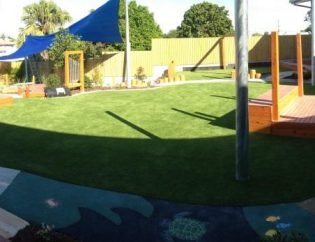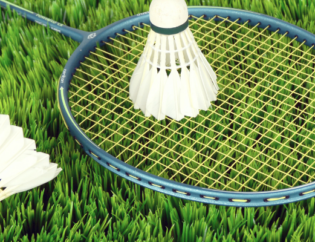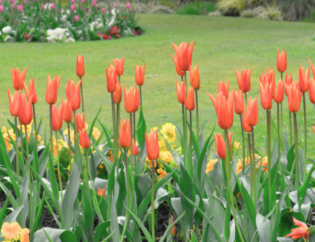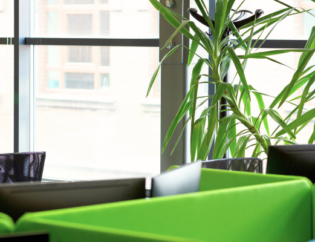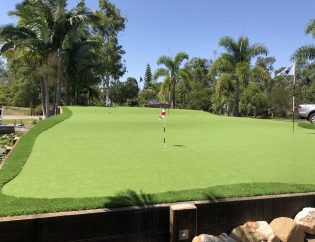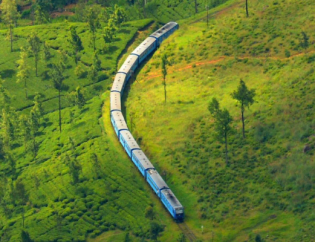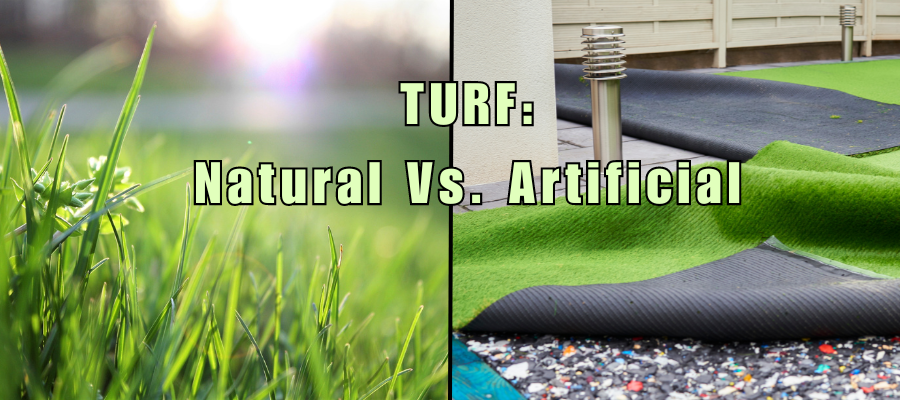
In this comprehensive guide, we’ll compare the advantages and disadvantages of both natural and artificial turf in regard to commercial properties to help you make an informed decision.
Which is best for you – fake or real grass? Read on for our comparison of Natural Grass vs. Artificial Grass
Natural Turf in Commercial Landscaping
Advantages:
1. Aesthetics of Natural Beauty:
Natural grass exudes a timeless charm with its lush, green appearance. It can enhance the visual appeal of any commercial property, providing a welcoming and natural setting. The vibrant green creates a soothing and inviting environment for students, visitors, or customers.
2. Environmental Benefits:
Natural grass contributes to carbon absorption and oxygen production, which is beneficial for the environment and air quality. This eco-friendly aspect makes it an attractive choice for those aiming to create a sustainable and green landscape.
3. Soft and Cushioned Surface:
For playgrounds, fields, etc. natural turf provides a soft and cushioned surface, reducing the risk of injuries during play or sports. The natural shock-absorbing properties of grass make it an ideal choice for areas where safety is a top priority.
Disadvantages:
1. High Maintenance:
Maintaining natural turf involves frequent mowing, watering, and fertilisation. This can be labour-intensive and costly, especially for large commercial properties. The need for regular upkeep can be a significant drawback. Because it takes time to grow, another part of maintenance is actually getting the grass ready for use and looking good, especially if you’re starting with seeds. While artificial grass is ready to use right away, natural grass could take a while.
2. Seasonal Variations:
Natural grass is subject to seasonal variations and weather-dependent growth, leading to potential aesthetic and functionality issues. Droughts, heavy rain, or extreme temperatures can impact the quality and appearance of the grass.
3. Susceptibility to Pests and Diseases:
Natural grass is prone to pests and diseases, which can require chemical treatments and further maintenance. The potential need for pesticides and herbicides may not align with sustainability goals.
Artificial Turf in Commercial Landscaping
Advantages:
1. Low Maintenance:
Artificial turf eliminates the need for mowing, watering, and fertilisation, significantly reducing maintenance costs. It provides a uniform appearance throughout the year, ensuring that your commercial property always looks well-kept and inviting.
2. Consistent Appearance:
Artificial turf maintains a lush appearance throughout the year, regardless of weather conditions. It doesn’t suffer from the seasonal changes that can affect natural grass. This consistency ensures that your property always looks its best.
3. Durability and Longevity:
Artificial turf can withstand heavy foot traffic and various activities, making it ideal for commercial properties like schools and playgrounds. It’s designed to last for many years, providing a durable surface that can endure daily wear and tear.
Disadvantages:
1. Initial Installation Cost:
The initial investment for artificial turf can be higher than natural grass. However, the long-term savings in maintenance costs often outweigh this expense. It’s important to view the initial cost as an investment in a low-maintenance, long-lasting solution.
2. Temperature Concerns:
In direct sunlight, artificial turf may become hot, making it less comfortable for users during the peak of summer. Proper shading and cooling strategies may be necessary to mitigate this issue and ensure user comfort.
3. Limited Environmental Benefits:
While artificial turf is more environmentally friendly than natural grass in terms of water usage, it doesn’t contribute to carbon absorption or oxygen production. Property owners looking for an eco-friendly solution may need to explore other ways to offset the environmental impact.
Key Considerations for Commercial Properties
When deciding between natural and artificial turf for your commercial property, consider these key factors:
- Safety: Assess how each option affects the risk of injuries. Ensure that the chosen turf meets safety standards and certifications.
- Cost: Conduct a comprehensive cost-benefit analysis, including initial investment and long-term maintenance expenses.
- Environmental Impact: Compare water usage, carbon footprint, and sustainability to align your choice with your environmental goals.
- Durability: Choose the option that can withstand the use and activities specific to your commercial property.
- Aesthetics: Balance the visual appeal of natural grass with the consistent appearance of artificial turf.
Aesthetics and Customisation
When it comes to the visual appeal of your commercial property, aesthetics play a crucial role. Both natural and artificial turf offer distinct opportunities for customisation to create a unique and inviting landscape.
Natural Grass vs. Artificial Grass
Natural Turf:
- Aesthetic Flexibility: Natural grass provides a dynamic canvas that can be tailored to your specific design preferences. You can shape the landscape by adjusting mowing patterns, planting flower beds, or even adding ornamental features such as topiaries or sculptures.
- Seasonal Variety: The changing seasons bring varying hues and textures, allowing your commercial property to continually evolve. Spring blossoms, summer greenery, and autumn foliage create a diverse and captivating backdrop.
- Eco-Friendly Landscaping: For those committed to eco-conscious landscaping, natural turf allows for the integration of native plants and wildflowers, which can attract pollinators and support local wildlife.
Artificial Turf:
- Consistency and Perfection: Artificial turf offers a uniform, well-manicured appearance throughout the year. This consistency ensures that your commercial property consistently looks its best, making a strong visual impact on visitors and passersby.
- Customisation Options: While artificial turf itself is consistent, it can be customised to suit your aesthetic preferences. You can choose from various shades of green to achieve a specific look and feel. Additionally, it’s an excellent canvas for corporate logos, school emblems, or patterns.
- Landscape Design: Integrating artificial turf with hardscapes, such as paved pathways, seating areas, and decorative elements, can result in an aesthetically pleasing and functional landscape.
The decision between natural and artificial turf for your commercial property is multifaceted. Careful consideration of factors like maintenance, environmental impact, safety, durability, aesthetics, and cost should guide your choice. Commercial property owners can benefit from the expertise and solutions provided by Turf Green Brisbane, a trusted provider of artificial turf solutions.
By making an informed decision, you can create a beautiful, safe, and functional landscape that aligns with your specific needs and values.
Are you ready to decide between natural or artificial grass for your commercial property? If you live somewhere between Brisbane and the Gold Coast in QLD, AustraliaContact Turf Green for advice and quotes.



